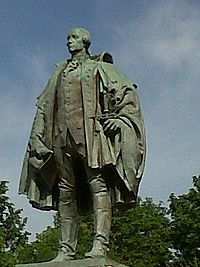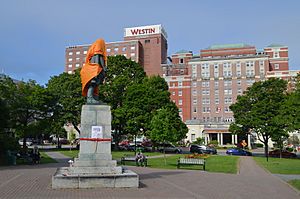Statue of Edward Cornwallis facts for kids
 |
|
| Location | Cornwallis Square, Halifax, Nova Scotia, Canada |
|---|---|
| Designer | J. Massey Rhind |
| Opening date | June 22, 1931 |
| Dedicated to | establishing Halifax and British rule of law |
| Dismantled date | January 31, 2018 |
The Statue of Edward Cornwallis was a bronze (metal) statue of a historical figure named Edward Cornwallis. It stood on a large stone base with information plaques. It was put up in 1931 in a park in Halifax, Nova Scotia, near the train station. Edward Cornwallis was the leader of Nova Scotia, called the Lieutenant Governor of Nova Scotia, from 1749 to 1752. He helped start the city of Halifax in 1749. A group called the Cornwallis Memorial Committee decided in the 1920s to build the statue to honor Cornwallis and attract visitors.
Since the 1980s, the statue caused a lot of disagreement. For some Mi'kmaq leaders, the statue showed the unfair treatment their people faced during the time of colonization and even today. But for many other people in Nova Scotia, the statue was a symbol of how the city was founded and had important local history. A historian named John G. Reid explained that the different views were about "how the past should be publicly remembered."
In 2018, the statue and its base were taken down by order of the Halifax Regional Council. They were worried about safety and the statue being damaged. A new committee has been formed to decide what will happen to the statue in the future.
Who Was Edward Cornwallis?
During his time as Governor of Nova Scotia, Edward Cornwallis helped create the towns of Halifax and Dartmouth. He also set up the first law courts and built forts in different areas. He organized a group of 840 soldiers and started a public school for children who had no parents. His leadership also led to the first Jewish community, the first German community, and the first Protestant church group in what is now Canada.
Cornwallis arrived in 1749 when the Miꞌkmaq people, who are Indigenous, were fighting back. They did not want Halifax to be built or the British to take over their traditional lands, called Miꞌkmaꞌki. The Mi'kmaq fighters attacked British settlements. In response, Cornwallis issued orders related to the Mi'kmaq people. This conflict, known as Father Le Loutre's War, continued even after Cornwallis left in 1752 and went back to England.
The Mi'kmaq, along with the French and Acadians, were later defeated in the French and Indian War. They made peace with the British through agreements called the Halifax Treaties. However, the Mi'kmaq still believe they own Miꞌkmaꞌki, and there are ongoing legal cases about land claims in New Brunswick and other places.
Building the Statue
In the late 1920s, Nova Scotia's leader, Edgar Nelson Rhodes, started the Cornwallis Memorial Committee. Their goal was to build a statue to recognize Edward Cornwallis as the "Founder of Halifax" and to help bring more tourists to the area.
The artist J. Massey Rhind created the statue. It was officially shown to the public on June 22, 1931. This date was the 182nd anniversary of Cornwallis's arrival in Halifax as the Lieutenant Governor of Nova Scotia. The statue was placed in the middle of a paved area in the new Cornwallis Park. It was across the street from the train station and the new Nova Scotian Hotel. The statue cost CA$20,000, and most of the money came from the Canadian National Railway.
The bronze statue was 9 feet (2.7 m) tall. It stood on a stone base that was 10 feet (3.0 m) tall. The statue was designed to look like ancient Roman statues of emperors, showing a sense of victory and importance. This design was chosen on purpose. Archibald MacMechan, who was on the committee, compared the founding of Halifax to the founding of ancient Rome. He praised Cornwallis's "strong character" and saw him as an example for "men of English blood" around the world who were proud of their achievements in building colonies.
During one of the speeches at the statue's unveiling, Cornwallis was described as having "a strong, steady face with a touch of seriousness." This was seen as a common trait in leaders and pioneers. The Mi'kmaq fighters had resisted throughout Father Le Loutre's War, stopping the British from fully controlling Mi'kma'ki. However, the speeches at the statue's unveiling mostly downplayed this resistance. They only briefly mentioned the Mi'kmaq as obstacles to settlement.
Taking Down the Statue
In April 2017, the city council decided to create a group of experts. This group would include Mi’kmaq representatives. Their job was to suggest how the city should deal with things that honor Cornwallis. At a meeting on July 18, 2017, the Mayor, Mike Savage, read a statement from a group called "Removing Cornwallis." This statement was about their call for action.
On July 1, 2017, a ceremony was held at the Cornwallis statue site in Halifax. It was a ceremony to remember missing Indigenous women. Five members of the Canadian Armed Forces, who called themselves members of the Proud Boys, interrupted the event. These five members were later suspended from the Forces, and the military leaders apologized. This incident helped bring more attention to claims against Cornwallis. It also supported the idea that the Mi'kmaq never gave up their land to the British, despite what some agreements like the Halifax Treaties might suggest. This means Nova Scotia is considered unceded Mi'kmaq land.
On July 15, a group of protesters came to the statue with the goal of taking it down. Workers from the City of Halifax arrived and covered the statue with a black tarp. The tarp stayed on while the protesters were there. After the city crew removed their covering, an orange tarp was put on the statue later that evening to hide it.
On January 31, 2018, the statue was removed. The City Council voted 12 to 4 in favor of moving the statue into storage. Both the statue and its stone base were put away.
On January 28, 2019, a teacher from Nova Scotia won a Governor General's History Award. She won it for her students' idea to keep the Cornwallis statue in Cornwallis Park. Their idea was to place the Cornwallis statue with three other statues. These would be of the Acadian Noel Doiron, the Black Nova Scotian Viola Desmond, and the Mi'kmaw hereditary grand Chief John Denny Jr.. The four statues would be arranged as if they were talking to each other, sharing their achievements and challenges.


